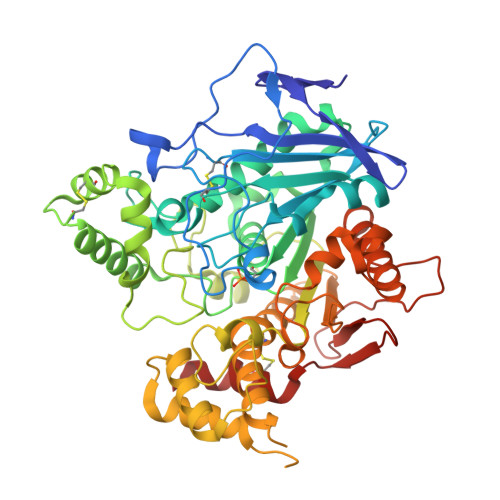Reaction of Cresyl Saligenin Phosphate, the Organophosphorus Agent Implicated in Aerotoxic Syndrome, with Human Cholinesterases: Mechanistic Studies Employing Kinetics, Mass Spectrometry, and X-Ray Structure Analysis.
Carletti, E., Schopfer, L.M., Colletier, J.P., Froment, M.T., Nachon, F., Weik, M., Lockridge, O., Masson, P.(2011) Chem Res Toxicol 24: 797
- PubMed: 21438623
- DOI: https://doi.org/10.1021/tx100447k
- Primary Citation of Related Structures:
2Y1K - PubMed Abstract:
Aerotoxic syndrome is assumed to be caused by exposure to tricresyl phosphate (TCP), an antiwear additive in jet engine lubricants and hydraulic fluid. CBDP (2-(ortho-cresyl)-4H-1,2,3-benzodioxaphosphoran-2-one) is the toxic metabolite of triortho-cresylphosphate, a component of TCP. Human butyrylcholinesterase (BChE; EC 3.1.1.8) and human acetylcholinesterase (AChE; EC 3.1.1.7) are irreversibly inhibited by CBDP. The bimolecular rate constants of inhibition (k(i)), determined under pseudo-first-order conditions, displayed a biphasic time course of inhibition with k(i) of 1.6 × 10(8) M(-1) min(-1) and 2.7 × 10(7) M(-1) min(-1) for E and E' forms of BChE. The inhibition constants for AChE were 1 to 2 orders of magnitude slower than those for BChE. CBDP-phosphorylated cholinesterases are nonreactivatable due to ultra fast aging. Mass spectrometry analysis showed an initial BChE adduct with an added mass of 170 Da from cresylphosphate, followed by dealkylation to a structure with an added mass of 80 Da. Mass spectrometry in (18)O-water showed that (18)O was incorporated only during the final aging step to form phospho-serine as the final aged BChE adduct. The crystal structure of CBDP-inhibited BChE confirmed that the phosphate adduct is the ultimate aging product. CBDP is the first organophosphorus agent that leads to a fully dealkylated phospho-serine BChE adduct.
Organizational Affiliation:
Laboratoire de Biophysique Moléculaire, Institut de Biologie Structurale, 41 Rue Jules Horowitz, 38027 Grenoble, France.






















